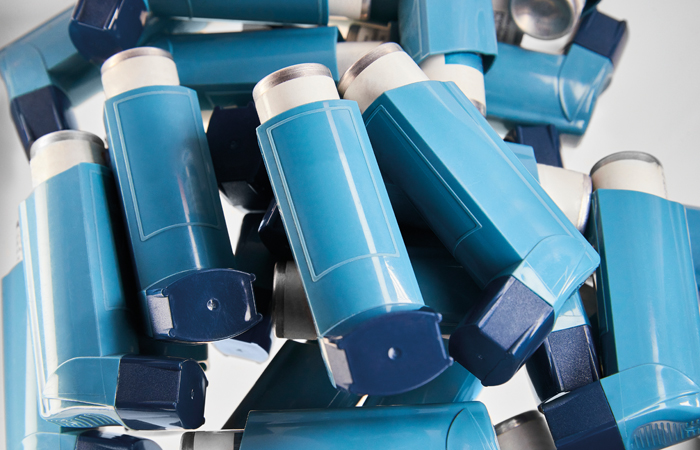In OTC
Follow this topic
Bookmark
Record learning outcomes
In July 2024, a survey by Asthma + Lung UK revealed that thousands of people could be living undiagnosed with incurable lung conditions such as asthma or chronic obstructive pulmonary disease (COPD), despite seeking medical help for coughs and chest infections. The charity found that over half of survey respondents were treated for their immediate chest symptoms, but didn’t have the underlying cause investigated at the time. According to the charity, 1.7 million people are living with COPD in the UK, and around 600,000 people are living undiagnosed. Previous analysis commissioned by Asthma + Lung UK shows that as many as 750,000 people in England are misdiagnosed with asthma, costing an estimated £132 million every year. “Persistent chest symptoms such as a cough or breathlessness always need investigating as they can be a feature of a number of conditions, including lung cancer and COPD,” says an Asthma + Lung UK spokesperson. “For anyone with a diagnosis of asthma who has constant symptoms, it is worth reviewing them. They might have poorly controlled asthma or a co-existing condition such as rhinosinusitis, gastro-oesophageal reflux, anxiety, a breathing pattern disorder or COPD.”
COPD
Chronic obstructive pulmonary disease (COPD) is actually a group of lung conditions, including chronic bronchitis and emphysema. In bronchitis, the airways become inflamed, causing a build-up of mucus (phlegm). Air can’t get out of the lungs easily due to narrowed or damaged airways, and people find it harder to breathe. In emphysema, the tiny air sacs in the lungs break down, causing bigger holes to form, trapping air inside them. Less oxygen can pass from the air inside the lungs into the bloodstream. Most people with emphysema also have chronic bronchitis.
Since COPD develops slowly over many years, many people don’t realise they have the condition in the earlier stages. They may have a recurrent cough or breathing problems that gradually get worse and limit their normal activities. If people can’t breathe properly, they often become less active, increasing the risk of other chronic conditions such as high blood pressure, heart disease, obesity and diabetes. According to an Asthma + Lung UK survey, one in eight people with COPD waited more than 10 years for their condition to be diagnosed.
“1.7 million people are living with COPD in the UK, and around 600,000 people are living undiagnosed”
Who is at risk?
COPD affects mainly middle-aged or older people who smoke or have smoked, especially if they have a close relative with the condition. It’s rarely diagnosed in the under 40s, and most people diagnosed are over the age of 50. It affects around nine per cent of people over 70. Smoking is thought to be responsible for around nine in every 10 cases, and the risk of developing COPD rises the more people smoke and the longer they have smoked. There is some evidence that regular passive smoking can increase the risk of the lung condition as well.
COPD may also be associated with long-term workplace exposure to dust fumes or chemicals that damage the lungs. Common culprits include cadmium, grain and flour dust, coat dust or welding fumes. Some research suggests that exposure to air pollution over a long period may also increase the risk of COPD, but the results aren’t conclusive.
In some people, COPD is due to a rare genetic abnormality that makes the lungs more vulnerable to damage. These people usually develop COPD at a younger age, especially if they smoke.
Spotting the symptoms
COPD doesn’t always cause noticeable symptoms at first. When symptoms occur, they may include:
- Feeling breathless, especially when active or during the night
- Having a persistent chesty cough
- Coughing up more mucus than usual
- Frequent chest infections
- Persistent wheezing.
These symptoms may be present all the time or flare up and down, often getting worse during the winter, in a smoky environment or during a respiratory infection such as a cold. In the more advanced stages, COPD symptoms may include weight loss, tiredness, swollen ankles, chest pain and coughing up blood.
Pharmacy customers with any of the above symptoms should speak to their GP, especially if they smoke or used to smoke. It’s important to treat COPD early on, before the lungs become significantly damaged. COPD can be mistaken for asthma, and vice versa. “Some people with asthma go on to develop COPD, and misdiagnosis can work both ways,” says professor Michael Crooks, professor of respiratory medicine at Hull York Medical School. “If someone with asthma is overusing salbutamol (blue) inhalers, they need a prompt review of their diagnosis and treatment. People with COPD, or combination COPD–asthma, pick up more blue inhalers than people with pure asthma. So, it’s important to look out for people who are picking up inhalers regularly or several at a time.”
Lung health check programmes to diagnose lung cancer can be an effective way to screen for lung diseases such as COPD. The FRONTIER project is a collaborative research project between Hull University Teaching Hospitals NHS Trust (now part of NHS Humber Health Partnership) and Chiesi UK & Ireland. Patients who previously attended an NHS Lung Health Check and reported symptoms of lung disease and/or had emphysema on their CT scan were invited back for further COPD testing. Results presented at the European Respiratory Society (ERS) Congress 2024 found that nearly 70 per cent of people assessed through the FRONTIER project were then diagnosed with COPD. “Our research shows that there are a lot of people who are living with COPD without a diagnosis,” says professor Crooks. “Many will have moderate to severe COPD symptoms. People with breathlessness often don’t go out much – visiting a pharmacy to get medicines may be the only time they leave the house. So, it’s important to make sure that pharmacy customers with any signs of breathlessness are taking up invitations to have lung health checks and lung cancer screening to access diagnosis and suitable treatments.”

Asthma is the most common lung disease in the UK, with around 73 million inhalers prescribed each year.
Lung cancer warning signs
According to Cancer Research UK, lung cancer is the third most common cancer in the UK. It’s more common as people get older, and more than eight out of 10 cases are caused by smoking. Lung cancer doesn’t always cause symptoms in its early stages, but red flag symptoms to be aware of include:
- Having a new cough or a cough most of the time
- Getting out of breath easily
- Coughing up phlegm (mucus) with blood in it
- An ache or pain in the chest or shoulder
- Chest infections that keep coming back or a chest infection that doesn’t get better
- Losing your appetite
- Feeling tired all the time
- Losing weight for no known reason.
“One in eight people with COPD waited more than 10 years for their condition to be diagnosed”
Care for COPD
According to professor Nicholas Hopkinson, professor of Respiratory Medicine and Honorary Consultant Physician at the National Heart and Lung Institute of Imperial College and the Royal Brompton Hospital, community pharmacy teams can help to ensure that people with COPD are receiving what the National Institute of Health and Care Excellence (NICE) guidance describes as the “Five Fundamentals of COPD care”. He says these five fundamentals are:
- Support to stop smoking
- Recommended NHS vaccinations (flu, pneumonia, Covid and respiratory syncytial virus (RSV))
- Pulmonary rehabilitation (know how to refer anyone limited by breathlessness)
- A written self-management plan (including identifying exacerbations and knowing what to do)
- Identifying and managing comorbidities (co-existing health conditions such as heart disease).
Professor Hopkinson’s research, published in the BMJ Open in April 2024, found that while annual COPD reviews are an important part of COPD management to reduce the risk of flare-ups and hospitalisation, many COPD patients are missing out on these reviews. “Make sure all patients with COPD have engaged with Asthma + Lung UK,” he says. “Encourage patients to fill out the COPD Patient Passport – this will give them a clear sense of what care they should be receiving.”
A 2023 Chiesi UK & Ireland survey of 200 COPD patients revealed that over half of respondents had felt hesitant to ask for more information about their COPD because of fear of judgement or discrimination. Upon diagnosis, only 34 per cent of patients said they received information on the emotional impact of COPD. Yet COPD can lead to anxiety and depression, especially when the symptoms are severe. Chiesi have recently initiated and funded the development of a patient resource called COPD&Me (copdandme.co.uk) for anyone living with COPD – and their support network. The platform’s aim is to help people living with COPD when searching for reliable and trusted information about their condition, when they are not with their doctor or healthcare team.

Lifestyle management
Stopping smoking may be the only treatment needed in the early stages of COPD to slow down the progression of the disease, and even people with advanced COPD should be encouraged to quit. According to Asthma + Lung UK, the most important intervention for pharmacy teams is to signpost someone with a diagnosis of COPD to smoking cessation services.
Professor Crooks says that pharmacy teams also need to encourage COPD patients to access pulmonary rehabilitation. This programme is designed specifically for people living with COPD, to help them manage their condition more effectively. “Pulmonary rehabilitation is not just an exercise programme,” he says. “It provides holistic care for each patient, including inhaler technique, strategies to cope with breathlessness, and general self-management. The programme views each patient as an individual and has many benefits. It’s also a way for patients to meet others in a similar situation. If patients aren’t sure whether to attend, they can always try out pulmonary rehabilitation before making a final decision.”
Medical management
COPD patients are usually prescribed inhalers to ease their breathlessness. If people are only short of breath when they’re active, they will be prescribed a short-acting bronchodilator to open up their airways quickly. If they feel breathless every day, they will be prescribed a long-acting bronchodilator, which usually only needs to be used once or twice a day. If someone is prone to flare-ups, they will usually be prescribed a combination inhaler, containing one or two bronchodilators and a steroid.
Improper inhaler technique can lead to underdosing and undertreatment. Pharmacy customers can be directed to videos on inhaler technique on the Asthma + Lung UK website: asthmaandlung.org.uk/living-with/inhaler-videos. “Inhalers are only effective if they are used correctly to make sure the medicine gets into the lungs,” says professor Crook. “Every time a patient is prescribed a new type of inhaler or an inhaler after a few months of not using one, the pharmacy team should discuss correct inhaler technique.”
If inhalers aren’t effective, patients may be prescribed a nebuliser so they can take in a large dose of medicine at a time. If COPD flare-ups are particularly severe, they may be prescribed a short course of steroid tablets, antibiotics for any signs of a bacterial chest infection and/or a mucolytic medicine if they are coughing up a lot of phlegm. Some people may be prescribed roflumilast tablets – this anti-inflammatory medicine is used to treat flare-ups in people whose symptoms have suddenly become worse at least twice over the past 12 months, and who are already using inhalers.
If COPD causes low blood oxygen levels, some people may be advised to have oxygen at home through nasal tubes or a mask. Very severe COPD may be treated with non-invasive ventilation (NIV). This involves wearing a mask connected to a machine that helps air get into the lungs and makes breathing easier. NIV is usually given in hospital but is occasionally given to people at home if their COPD is severe but stable. Surgery to remove part of the lung, or a full lung transplant, is usually only suitable for a small number of people with severe COPD whose symptoms aren’t controlled with medicines.
Inhaler recycling schemes
Asthma is the most common lung disease in the UK, with around 73 million inhalers prescribed each year. Inhalers account for around three and a half per cent of carbon emissions generated by the NHS. Most inhalers are disposed of in household general waste, releasing harmful greenhouse gases into the atmosphere. In 2022, a Chiesi survey of 500 asthma patients found that 53 per cent didn’t realise inhalers couldn’t be put in their council recycling bin, and 77 per cent would recycle their inhalers more regularly if they could just post them to a recycling centre.
All used or unwanted inhalers should be returned to a pharmacy to be disposed of safely in medical waste. However, inhaler recycling schemes aren’t available in all areas, and many local schemes are pilots rather than permanent fixtures. In September 2023, Grundon Waste Management launched a UK-wide inhaler return and recycling scheme. Community pharmacies (as well as pharmacies at GP surgeries and hospitals) can sign up to the scheme on the Grundon website: grundon.com/services/clinical-waste/inhaler-recycling.



